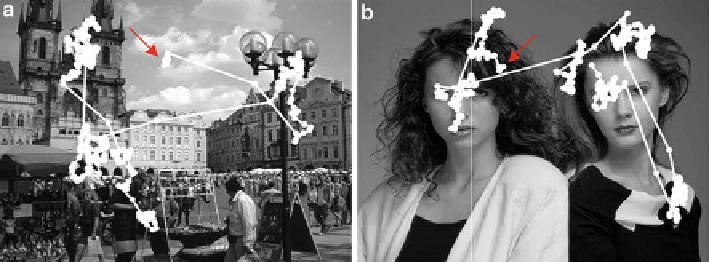Biomedical Engineering Reference
In-Depth Information
Fig. 18
Scene square and portrait - eye movement over the observed images during first 6s,
red
arrows
identify initial observing point
caused by noise. The next important factor is the faithfulness of skin tone. The
next important factor that plays an important role is the content of the image for
the observer, this increases the attraction of the image observed. An attempt was
made to mathematically express this feature as a criterion of image activity, which
is defined as follows:
X
i
D
1
jo
i
N
1
N
PA D
f
i
j;
where
N
represents number of the image pixels,
o
i
is original image and
f
i
is original
image filtered by median filter with kernel 8
8pixels.
PA
describes local activities
in the image thereby categorize image from the size of the areas with the same color.
This criterion (
PA
) is dependent on the image content and partially correspondent
with human visual features. Presented scenes (Fig.
18
) PORTRAIT (
PA
D
4.83) a
SQUARE (
PA
12.07) represents images with high and low picture activity. At the
images with high
PA
there are less eye saccadic movements during the observation
than at the images with low
PA
. This can be evaluated for example with parameter
saccadic trajectory that summing length of saccadic movements with velocity higher
than 20
ı
/s [
22
,
23
]. More about PA can be found in [
21
].
Thus an important finding from this experiment can be discussed. The test
sequences show that during an analysis of a “quality” image the human eye first
analyses the areas of high frequencies and favours skin tone. Hence, for assessing
the quality of an image, quality edges in the image and the faithfulness of the skin
tone are of prime importance. In compressed images, the edges generally get less
distinct and therefore the relevant quality is assessed as worse. It is the same for
skin tone, though with compression it is not very distorted. This phenomenon of
distorting the tone is known, for instance, in analogue television systems NTSC
(distorting the differential phase).
D

